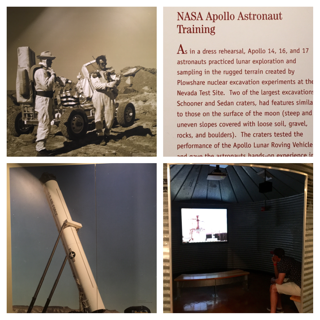EXTRA
CREDIT EVENT
DESMA 9
DESMA 9
July 2016
My visit to the National Atomic Testing Museum
in Las Vegas, Nevada fit in great with this week’s lecture on space
exploration. Professor Vesna summarizes how the science and technology we have learned
about thus far, has been integrated into
the exploration of space. It has
played a big role on the advancement of technology and of broadening the
artistic scope. She also discussed the Space Race and
the atomic bomb. Coincidentally, this museum has everything you would ever want
to know about atomic energy and the U.S. nuclear bomb. The whole museum is dedicated to
sharing cold war history between the U.S. and the U.S.S.R. The competition between the United
States and the Soviet Union was an event that impacted the entire world and the
Atomic bombs that had been developed caused threats between the U.S. and
U.S.S.R.
This museum
is associated with the Smithsonian so everything is done well. There are
various exhibits showing the science and technology used in developing atomic
bombs as well as the history of testing bombs in the desert near Las Vegas. You
will also find information on area 51. Area 51 is about 83 miles from Las
Vegas. It is the most famous secret military base in the country with a lot of
rumors that circled around it. Although it has never been declared an official
“secret military base”, all research and activities conducted there are top
secret. There is a limited time “Area 51 Exhibit” going on right now which I found
it to be very interesting. As you enter the dark Area 51 room with glow in the
dark writing all over the walls, you are greeted by a deep voice who welcomes
you but makes you feel as if you are being recruited I read a lot of
interesting news articles about UFO’s from the people who first witnessed them.
There were a lot of other extraterrestrial related objects such as aliens and
other artifacts. Afterwards you are left
asking yourself is there really life on another planet with extraterrestrial
objects and beings?
PHOTOS FROM MY VISIT TO
THE NATIONAL ATOMIC TESTING MUSEUM
The tours are
self guided and you can take as many photos as you’d like, however there are no
photographs allowed in the Area 51 exhibit. I would recommend this museum to
anyone interested in cold war history and the atomic bomb.
Sources
"Atomic Bomb." HISTORY. N.p., 2014. Web. 23 July 2016.
"DarkGovernment." DarkGovernment. N.p., n.d. Web. 23 July 2016.
Vesna , Victoria, dir. Space Part 2. 2015. Film. 22 July 2016













